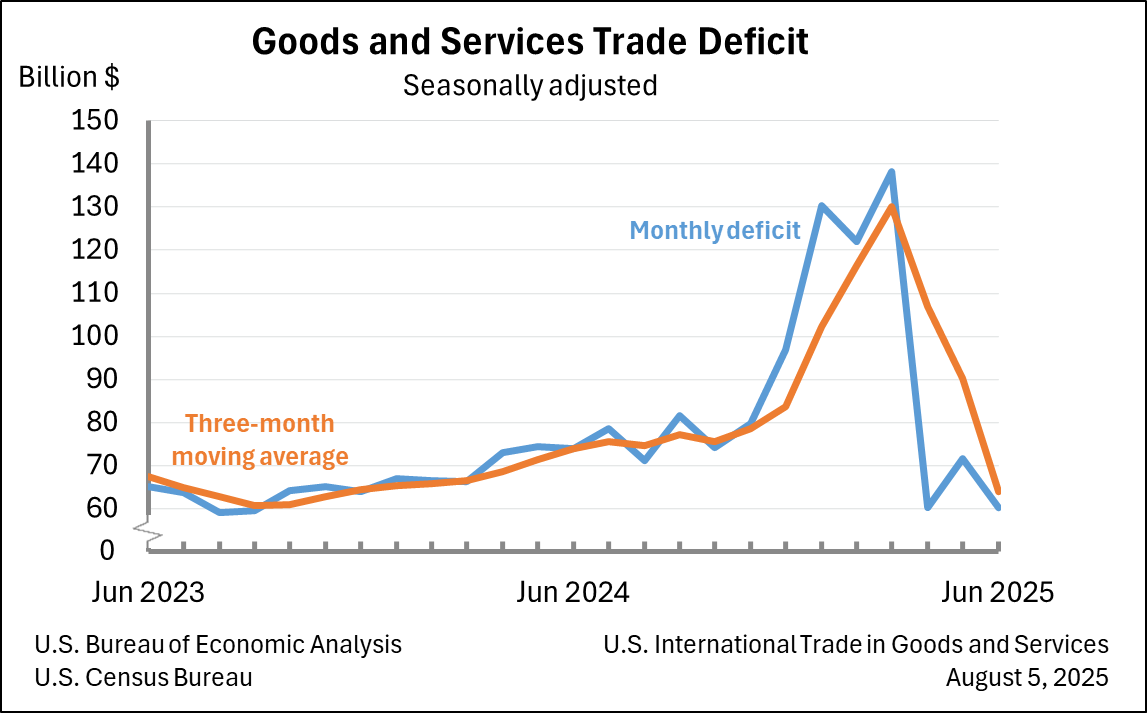Bureau of Economic Analysis
U.S. International Trade in Goods and Services, June 2025
The U.S. goods and services trade deficit decreased in June 2025 according to the U.S. Bureau of Economic Analysis and the U.S. Census Bureau. The deficit decreased from $71.7 billion in May (revised) to $60.2 billion in June, as exports decreased less than imports. The goods deficit decreased $11.4 billion in June to $85.9 billion. The services surplus increased $0.1 billion in June to $25.7 billion.
Principal Federal Economic Indicators
Noteworthy
- 2025 News Release Schedule
- Innovation at BEA
- 2025 Annual Updates
- Distribution of Personal Income Nowcast
- New! Services Trade Data for More Countries
- Data Tool: Trade in Value Added
- Updated: RIMS II Regional Multipliers
- Arts and Culture
- Space Economy
- FDI Now in State BEARFACTS
- Quick Guide: Price Indexes
The Latest
Direct Investment by Country and Industry, 2017
In 2017, the U.S. direct investment abroad position increased to $6,013.3 billion and the foreign direct investment in the United States position increased to $4,025.5 billion, according to statistics released by the Bureau of Economic Analysis (BEA). The increases were mainly due to increased investment with countries in Europe.
GDP Increases in Second Quarter
Real gross domestic product (GDP) increased 4.1 percent in the second quarter of 2018, according to the “advance” estimate released by the Bureau of Economic Analysis. In the first quarter, real GDP increased 2.2 percent (revised).
BEA’s 15th Comprehensive Update Improves Measurement of the Economy
BEA has updated gross domestic product and related statistics covering the past five years, and in some cases reaching back decades, to reflect newly available source data; improved seasonal adjustment; innovations in measuring the prices of software, medical equipment, and cellphones; and more.
Gross Domestic Product, 2nd quarter 2018 (advance estimate), and comprehensive update
Real gross domestic product increased at an annual rate of 4.1 percent in the second quarter of 2018 (table 1), according to the "advance" estimate released by the Bureau of Economic Analysis. In the first quarter, real GDP increased 2.2 percent (revised).
Gross Domestic Product by State, 1st quarter 2018
Real gross domestic product (GDP) increased in 48 states and the District of Columbia in the first quarter of 2018, according to statistics released today by the U.S. Bureau of Economic Analysis. The percent change in real GDP in the first quarter ranged from 3.6 percent in Washington to -0.6 percent in North Dakota.
Gross Domestic Product by Industry: First Quarter 2018
Real estate and rental and leasing; information; and nondurable goods manufacturing were the leading contributors to the increase in U.S. economic growth in the first quarter of 2018. Overall, 14 of 22 industry groups contributed to the 2.0 percent increase in real GDP in the first quarter.
Gross Domestic Product by Industry, 1st quarter 2018
Real estate and rental and leasing; information; and nondurable goods manufacturing were the leading contributors to the increase in U.S. economic growth in the first quarter of 2018. According to gross domestic product (GDP) by industry statistics released by the Bureau of Economic Analysis, 14 of 22 industry groups contributed to the overall 2.0 percent increase in real GDP in the first quarter.
New Foreign Direct Investment in the United States, 2017
Expenditures by foreign direct investors to acquire, establish, or expand U.S. businesses totaled $259.6 billion in 2017, down 32 percent from $379.7 billion in 2016.
Additional highlights of the statistics on new foreign direct investment for 2017:
New Foreign Direct Investment in the United States: 2017
Expenditures by foreign direct investors to acquire, establish, or expand U.S. businesses totaled $259.6 billion (preliminary) in 2017. Expenditures were down 32 percent from $379.7 billion (revised) in 2016 and were below the annual average of $359.9 billion for 2014-2016. As in previous years, acquisitions of existing businesses accounted for a large majority of total expenditures.




